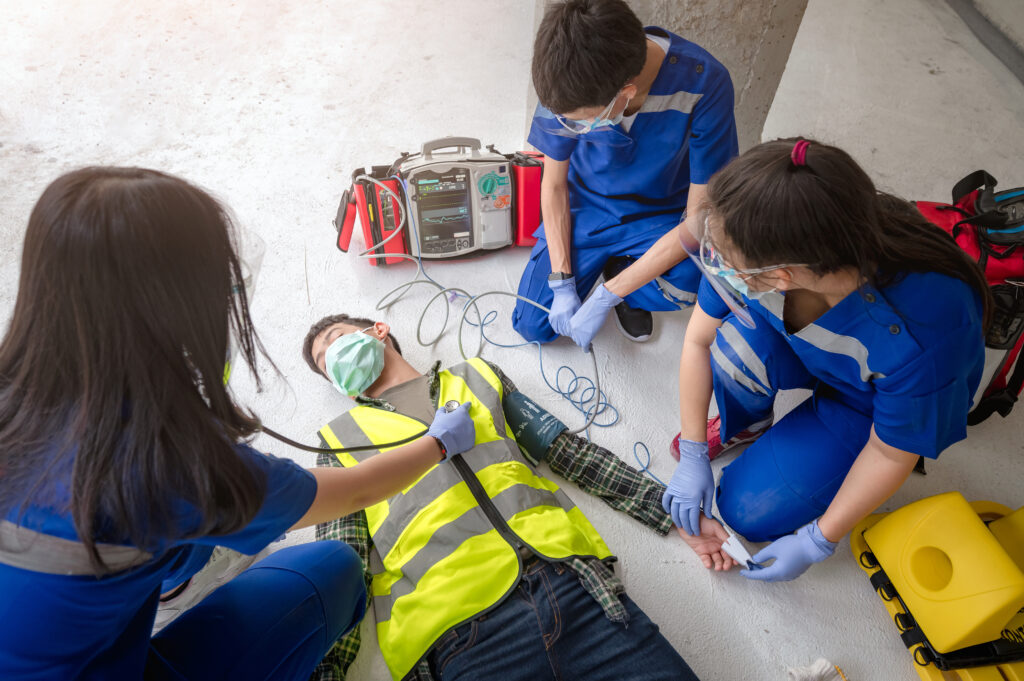

The Lifesaving Duo: CPR and AED Training in the Workplace
In the bustling world of workplaces, where tasks are juggled and deadlines met, it’s easy to overlook the importance of preparedness for unforeseen emergencies. Yet, in any environment, from the corporate office to the factory floor, accidents can happen, and sudden cardiac events can strike without warning. In such critical moments, the availability of trained individuals who can perform CPR (Cardiopulmonary Resuscitation) and utilize an AED (Automated External Defibrillator) can be the difference between life and death.
Why is CPR and AED training so crucial in the workplace?
Rapid Response to Cardiac Arrest:
- Cardiac arrest is a leading cause of death globally. In the workplace, where employees spend a significant portion of their day, the risk of cardiac events is not to be underestimated. CPR and AED training empower individuals to respond immediately, maintaining blood flow and oxygenation to vital organs until professional medical help arrives.
Every Second Counts:
- The importance of a timely response cannot be overstated. For every minute that passes without defibrillation, the chance of survival for a cardiac arrest victim decreases by approximately 10%. With each passing minute, the stakes become higher. Having trained employees who can provide immediate assistance can be a lifesaver.
Versatile Applicability:
- CPR and AED training are not restricted to any specific industry. Whether you work in an office, a factory, a retail store, or any other setting, the skills learned are universally applicable. Accidents and medical emergencies can happen anywhere.
Increased Workplace Safety:
- A workplace that prioritizes the safety and well-being of its employees fosters a culture of trust and commitment. CPR and AED training demonstrate an organization’s dedication to the health and safety of its workforce, boosting morale and retention.
Legal and Regulatory Compliance:
- In many regions, there are legal requirements for workplaces to have AEDs and trained personnel. Failing to comply with these regulations can result in penalties. Additionally, demonstrating compliance can be a strong point in legal defense in case of workplace-related cardiac emergencies.
The Synergy of CPR and AED
CPR and AED are a lifesaving duo. While CPR helps maintain circulation, keeping the heart and brain supplied with oxygen, AEDs are designed to restore normal heart rhythms. AEDs are user-friendly devices that provide voice and visual prompts, guiding rescuers through the process. Together, CPR and AED use significantly increase the odds of survival in cases of sudden cardiac arrest.
Creating a Safer Workplace
How can organizations create a safer workplace through CPR and AED training?
Training Programs:
- Invest in comprehensive CPR and AED training programs for your employees. These programs should cover not only the practical skills but also the theoretical knowledge needed to understand the importance of timely intervention.
Regular Refresher Courses:
- Skills can fade over time. Schedule regular refresher courses to ensure that employees maintain their proficiency in CPR and AED use.
AED Placement:
- Strategically place AEDs throughout the workplace, making sure they are easily accessible. Ensure that employees know the exact locations of these devices.
Designate Responders:
- Identify and train specific employees as designated responders. They should be responsible for initiating the response to a cardiac event, including calling for help, performing CPR, and using the AED.
Raise Awareness:
- Promote awareness of CPR and AED availability within the workplace. Encourage employees to report any potential cardiac event promptly.
In the workplace, where employees spend a significant portion of their lives, health and safety should be paramount. CPR and AED training are not just optional extras; they are essential elements of a safe and responsible work environment. By investing in these skills and resources, organizations demonstrate their commitment to employee well-being and, in some cases, their legal and regulatory obligations. Moreover, they empower their employees to be heroes in critical moments, ready to respond when every second counts.
By providing CPR and AED training to remote workers, employers send a clear message that they prioritize safety, no matter where work is conducted. This commitment to safety can enhance employee morale, loyalty, and overall job satisfaction.
CPR and AED training are essential in remote sites because they save lives, fulfill legal obligations, empower employees to respond to emergencies, and contribute to a culture of safety. Regardless of where employees work, ensuring their health and well-being should always be a top priority for organizations. Let’s take a pledge to make our workplaces safer. Let’s equip ourselves and our colleagues with the skills and knowledge needed to save lives. In doing so, we not only protect our coworkers but also create a culture of preparedness, care, and compassion that extends far beyond the workplace.




